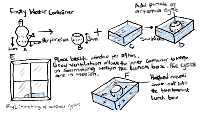Review of Artemia salina L. hatching methods and lessons for the Nigerian Ecotoxicologist
Keywords:
Brine shrimp, in-vivo, toxicological investigations, cystAbstract
Artemia salina also known as the brine shrimp has been used for in-vivo toxicological investigations for quite some time and different methods of hatching the cysts have been developed by researchers worldwide. However, the nigerian ecotoxicologist is faced with the challenge of availability of the cyst in small packs, epilleptic power supply and dense population of scientists in the hinterland who may not have access to natural seawater, therefore there is need to develop a kit that can work for nigerian scientists. This review thus highlights some of the existing methods used in hatching the cyst, comprehensive details of the methods were given, prospects and constraints were listed and the design of NigArtoxKit is proposed. Hatching the brine shrimp requires continous aeration and illumination in a saline medium so the design of the kit should consider identification of artemia strain most suitable for nigerian environment with diverse regional weather variations. Alternative medium to seawater must be explored while source of power for continous aeration and illumination can be incorporated into the design.
Downloads
References
Abimbade, S.F. (2010). Phytochemical evaluation and Biological activities of stem and leaves of dumb cane plant (Dieffenbachia picta). M.Sc. Dissertation, University of Ibadan. 82p
Barahona, M.V. and Sanchez-Fortun, S. (1999). Toxicity of carbamates to the brine shrimp Artemia salina and the effect of atropine, BW284c51, iso- OMPA and 2-PAM on carbaryl toxicity. Environ Pollut 104: 469–76.
Bottalico, A., Capasso, R., Evidente, A., Randazzo, G., and Vurro, M. (1990). Cytohalassins: Structure-activity relationships. Phytochemistry 29:93-96.
Cáceres, A. (1996). Plantas de Uso Medicinal en Guatemala. 1ª ed. Editorial Universitaria: San Carlos de Guatemala. 328p .
Cains, J. Jr. and Pratt, J.R. (1989). The scientific basis of bioassays. In:Environmental Bioassay Techniques and their application. (Eds M. Munawar, G. Dixon, C.I. Mayfield, T. Reynoldson and H. Sadah, pp, 5-20.
Kluwer Academic Publishers, Dordrecht.Caldwell, G.S,M., Bentley, G. and Olive, P. J.W. (2003). The use of a brine shrimp (Artemia salina) bioassay to assess the toxicity of diatom extracts and short chain aldehydes. Toxicon 42: 301–306.
Coe, F. G., Parikh, D. M., and Johnson, C. A. (2010). Alkaloid presence and brine shrimp (Artemia salina) bioassay of medicinal species of Eastern Nicaragua. Pharm Biol. 2010 Apr ;48 (4):439-45.
Elnabarawy, M.T. and Welter, A.N. (1984). Utilization of algal cultures and assays by industry. In: Algae as Ecological Indicators. (Ed. L. E. Shubert), pp 317-328. Academic Press, New York.
Ferrigni, N.R., Meyer, B.N., McLaughlin, J.L., Keller, W. (1984). Using brine shrimp to determine structure-activity relationships among lupin alkaloids. Int. J. Crude Drug Res. 22: 169-172.
Food Agriculture Organization (1977). Manual of methods in aquatic environment research. Part 4. Bases for selecting biological tests to evaluate marine pollution. FAO Fish. Tech. Pap. (l64):3l p.
Fumaral, F., and Garchitorena, M. (1996). Artemia salina. Recolección, descapsulación y desarrollo. Revista Aquamar. Año 4 Nº 3: 22–4.
Grzimeks, B. (1974). Animal Life Encyclopedia: Lower Animals (Vol 1). Van Nostrand Reinhold Company. NY. 600p
Harwig, J. and Scott, P. M. (1971). Brine Shrimp (Artemia salina L.) Larvae as a Screening System for Fungal Toxins. Applied Microbiology, 21(6): 1011-1016
Hodgson, E. (2004). Introduction to Toxicology, In: Hodgson E. (ed) A Textbook of Modern Toxicology. 3rd ed. John Wiley & Sons, Inc. pp 3- 12.
Johnston, N.E. and Rusche, B. (1997). Ethics committees: how do they contribute to the Three Rs? Synopsis of the workshop. Animal Alternative, Welfare and Ethics. Edited by L.F.M Van Zutphen and M. Balls Elsevier Developments in animal and Veterinary Sciences: 391–5.
Lewan L., Andersson M., and Morales-Gomez, P. (1992). The use of Artemia salina in toxicity testing. Alternatives To Laboratory Animals. 20:297–301.
Lewis, M.A. (1993). Freshwater Primary Producers, In: Calow P. (ed) Handbook of Ecotoxicology, Blackwell Publishers, Oxford. 1: 28-50.
Massele, A.Y., and Nshimo, C. M. (1995). Brine shrimp bioassay for biological activity of medicinal plants in traditional medicines in Tanzania. East Afr. Med. J. 72(10): 661–663.
Matthews, R.S. (1995). Artemia salina as a test organism for measuring superoxide-mediated toxicity. Brief Communication. Free Radical Biology and Medicine 18(5):919-922.
Mayfield C.I. (1993). Microbial Systems. In: Calow P. (ed) Handbook of Ecotoxicology, Blackwell Publishers, Oxford. 1: 9-27.
Meyer,B.N., Ferrigni, N.R., Putnam, J.E., Jacobsen, L.B., Nichols, D.E., and McLaughlin, J.L. (1982). Brine shrimp: a convenient general bioassay for active plant constituents. Planta Med.45 (5):31-4
Middaugh, D.P., Goodman, L.R., and Hemmer, M.J. (1993). Methods for Spawning, Culturing and Conducting Toxicity tests with Early Life Stages of Estuarine and Marine Fishes. In: Calow P. (ed) Handbook of Ecotoxicology, Blackwell Publishers, Oxford. 1: 167-192.
Nasha, S.B.M., Quayle, P.A., Schreiber, U., and Muller, J.F. (2005). The selection of a model microalgal species as biomaterial for a novel aquatic phytotoxicity assay. Aquatic Toxicology 72: 315–326.
Nondo, R.S., Mbwambo, Z.H., Kidukuli, A.W., Innocent, E.M., Mihale, M.J., Erasto, P and Moshi, M.J. (2011) Larvicidal, Antimicrobial and Brine shrimp Activities of Extracts from Cissampelos mucronata and Tephrosia villosa from Coast region, Tanzania. BMC Complement Altern Med.23; 11 (1):33
Nyholm, N., and Kallqvist , T. (1989). Methods for growth inhibition toxicity tests with freshwater algae. Environ. Toxicol. Chem. 8: 689-703.
Park, T., Bolch, C. J. S. and Hallegraeff, G.M. (2007). Larval Crassostrea bivalve and Artemia brine shrimp bioassays to assess toxicity and micropredation by the heterotrophic dinoflagellates Cryptoperidiniopsis brodyi and Pfiesteria piscicida from Australian waters. Journal of Plankton Research 29(9): 791–801. Available online at www.plankt.oxfordjournals.org. Downloaded from http://plankt.oxfordjournals.org/ at AGORA Nigeria on October 26, 2011
Parra, A.L., Yhebra, R.S., Sardiñas, I.G. and Buela, L.I. (2001). Comparative study of the assay of Artemia salina L. and the estimate of the medium lethal dose (LD50 value) in mice, to determine oral acute toxicity of plant extracts. Phytomedicine, 8(5): 395–400.
Persoone G and Janseen, G.R. (1993) Freshwater Invertebrate Toxicity Tests. In: Calow P. (ed) Handbook of Ecotoxicology, Blackwell Publishers, Oxford. 1: 51-65
Reish, D.J. and Oshida, P.S. (1986) Manual of methods in aquatic environment research. Part 10. Short-term static bioassays. FAO Fish.Tech. Pap. , (247);62 p.
Richter, J.A. and Goldstein, A. (1970). The effects of morphine compounds on the light responses of the brine shrimp Artemia salina. Psychopharmacologia (Berl) 17: 327-337.
Sánchez, C., Gupta, M., Vásquez, M., Noriega, Y., and Montenegro, G. (1993). Bioensayo con Artemia salina para predecir la actividad antibacteriana y farmacológica. Revista Médica de Panamá. 18: 62–9.
Sanchez-Fortun, S., Sanz-Barrera, F., and Barahona-Gomariz, M.V. (1995). Acute toxicities of selected insecticides to the aquatic arthropod Artemia salina. Bull. Environ. Contam. Toxicol. 54(1): 76–82.
Schott, K., Schneider, G., and Oepen, H.A. (1980). Pharmacological and behavioural study on B,B’-immunodipropionitrile (IDPN)-treated brine shrimp Artemia salina L. Toxicol. Lett. 6:231-234.
Sirois, D.L. (1990). Evaluation of protocols for the assessment of phytotoxicity. In: Plants for Toxicity Assessment. ASTM STP 1091 (Eds W.Wang, J.W. Gorsuch and W.R. Lower), pp. 225-234. ASTM, Philadelphia.
Taha, A and Alsayed, H. (2000). Brine shrimp bioassay of ethanol extracts of Sesuvium verrucosum, Salsola baryosma and Zygophyllum quatarense. Medicinal Plants from Bahrain. Short Communication, Phytother. Res. 14, 48–50.
Treece, G.D. (2000). Artemia production for marine larval fish culture. Southern Regional Aquaculture Centre (SRAC Publication No. 702).
Yajes, R. (1997). Animal ethics committees and the implementation of the Three Rs. Animal Alternatives, Welfare and Ethics. Edited by LFM Van Zutphen and M. Balls Elsevier Developments in Animal and Veterinary Sciences: 367–71,

Downloads
Published
Issue
Section
License

This work is licensed under a Creative Commons Attribution-NonCommercial-ShareAlike 4.0 International License.







